MHD Free Convection and Entropy Generation in a Corrugated Cavity Filled with a Porous Medium Saturated with Nanofluids
Abstract
1. Introduction
2. Mathematical Formulation
- At the bottom and top walls:,
- At the right vertical wall:,
- At the corrugated left wall:.
3. Solver and Code Validation
4. Results and Discussion
5. Conclusions
- Increasing the Grashof number and Darcy number results in heat transfer enhancement while keeping other parameters fixed.
- The imposed frequency of the triangular wave affects the variation of the local Nusselt number for the corrugated wall. The velocity and temperature distributions are very sensitive to the corrugation frequency near the heated wall.
- Increasing the corrugation frequency reduces the local and average Nusselt number.
- The effect of the frequency of the triangular wave on the average Nusselt number is significant at higher values of the Grashof and Darcy numbers.
- The magnetic field reduced the convective heat transfer.
- Thirty-four-point-four percent of the average Nusselt number enhancement is obtained for the nanofluid with a nanoparticle volume fraction of when it is compared to the base fluid () for the flat wall.
- The normalized total entropy generation increases as the values of the Da number (due to the fluid friction irreversibility) and increase and the Ha number decreases (suppression of convection). The discrepancy between the normalized entropy generation for a flat and a corrugated wall is more pronounced for the highest values of the Darcy and Hartmann numbers.
Author Contributions
Funding
Conflicts of Interest
Abbreviations/Nomenclature
| a | length of triangular wave (m) |
| b | height of triangular wave (m) |
| B | magnetic field strength |
| Da | Darcy number, |
| Gr | Grashof number, |
| h | local heat transfer coefficient (W/mK) |
| Ha | Hartmann number, |
| k | thermal conductivity (W/m·K) |
| H | length of the enclosure (m) |
| n | unit normal vector |
| Nu | local Nusselt number |
| p | pressure (Pa) |
| P | non-dimensional pressure |
| Pr | Prandtl number, |
| T | temperature (K) |
| u, v | x-y velocity components (m/s) |
| U, V | dimensionless velocity components |
| x, y | Cartesian coordinates (m) |
| X, Y | dimensionless coordinates |
| Greek characters: | |
| thermal diffusivity (m/s) | |
| expansion coefficient (1/K) | |
| nanoparticle volume fraction | |
| non-dimensional temperature, | |
| kinematic viscosity (m/s) | |
| density of the fluid (kg/m) | |
| electrical conductivity (S/m) | |
| Subscripts: | |
| c | cold wall |
| m | average |
| h | hot wall |
References
- Pop, I.; Ingham, D. Convective Heat Transfer: Mathematical and Computational Modeling of Viscous Fluids and Porous Media; Pergamon: Oxford, UK, 2001. [Google Scholar]
- Bejan, A.; Dincer, I.; Lorente, S.; Miguel, A.; Reis, A. Porous and Complex Flow Structures in Modern Technologies; Springer: New York, NY, USA, 2004. [Google Scholar]
- Vafai, K. Porous Media: Applications in Biological Systems and Biotechnology; CRC Press: New York, NY, USA, 2010. [Google Scholar]
- Sankar, M.; Kiran, S.; Ramesh, G.; Makinde, O. Natural convection in a non-uniformly heated vertical annular cavity. Defect Diffus. Forum 2017, 377, 189–199. [Google Scholar] [CrossRef]
- Nkurikiyimfura, I.; Wang, Y.; Pan, Z. Heat transfer enhancement by magnetic nanofluids—A review. Renew. Sustain. Energy Rev. 2013, 21, 548–561. [Google Scholar] [CrossRef]
- Hasanuzzaman, M.; Oztop, H.F.; Rahman, M.; Rahim, N.; Saidur, R.; Varol, Y. Magnetohydrodynamic natural convection in trapezoidal cavities. Int. Commun. Heat Mass Transf. 2012, 39, 1384–1394. [Google Scholar] [CrossRef]
- Selimefendigil, F.; Oztop, H.F. Effect of a rotating cylinder in forced convection of ferrofluid over a backward facing step. Int. J. Heat Mass Transf. 2014, 71, 142–148. [Google Scholar] [CrossRef]
- Yu, P.; Qiu, J.; Qin, Q.; Tian, Z.F. Numerical investigation of natural convection in a rectangular cavity under different directions of uniform magnetic field. Int. J. Heat Mass Transf. 2013, 67, 1131–1144. [Google Scholar] [CrossRef]
- Oztop, H.F.; Abu-Nada, E. Numerical study of natural convection in partially heated rectangular enclosures filled with nanofluids. Int. J. Heat Fluid Flow 2008, 29, 1326–1336. [Google Scholar] [CrossRef]
- Selimefendigil, F.; Oztop, H.F. Pulsating nanofluids jet impingement cooling of a heated horizontal surface. Int. J. Heat Mass Transf. 2014, 69, 54–65. [Google Scholar] [CrossRef]
- Sheikholeslami, M.; Bandpy, M.G.; Ganji, D. Numerical investigation of MHD effects on Al2O3-water nanofluid flow and heat transfer in a semi-annulus enclosure using LBM. Energy 2013, 60, 501–510. [Google Scholar] [CrossRef]
- Hamad, M.; Ismail, I.P.A. Magnetic field effects on free convection flow of a nanofluid past a vertical semi-infinite flat plate. Nonlinear Anal. Real World Appl. 2010, 12, 1338–1346. [Google Scholar] [CrossRef]
- Mahmoudi, A.H.; Pop, I.; Shahi, M. Effect of magnetic field on natural convection in a triangular enclosure filled with nanofluid. In. J. Therm. Sci. 2012, 59, 126–140. [Google Scholar] [CrossRef]
- Ghasemi, B.; Aminossadati, S.; Raisi, A. Magnetic field effect on natural convection in a nanofluid-filled square enclosure. Int. J. Therm. Sci. 2011, 50, 1748–1756. [Google Scholar] [CrossRef]
- Sun, Q.; Pop, I. Free convection in a triangle cavity filled with a porous medium saturated with nanofluids with flush mounted heater on the wall. Int. J. Therm. Sci. 2011, 50, 2141–2153. [Google Scholar] [CrossRef]
- Bourantas, G.; Skouras, E.; Loukopoulos, V.; Burganos, V. Heat transfer and natural convection of nanofluids in porous media. Eur. J. Mech. B-Fluids 2014, 43, 45–56. [Google Scholar] [CrossRef]
- Nielda, D.; Kuznetsov, A. Forced convection in a parallel-plate channel occupied by a nanofluid or a porous medium saturated by a nanofluid. Int. J. Heat Mass Transf. 2014, 70, 430–433. [Google Scholar] [CrossRef]
- Cheng, C.Y. Natural convection boundary layer flow over a truncated cone in a porous medium saturated by a nanofluid. Int. Commun. Heat Mass Transf. 2012, 39, 231–235. [Google Scholar] [CrossRef]
- Cimpean, D.S.; Pop, I. Fully developed mixed convection flow of a nanofluid through an inclined channel filled with a porous medium. Int. J. Heat Mass Transf. 2012, 55, 907–914. [Google Scholar] [CrossRef]
- Pekmen, B.; Sezgin, M.T. MHD flow and heat transfer in a lid-driven porous enclosure. Comput. Fluids 2014, 89, 191–199. [Google Scholar] [CrossRef]
- Guedda, M.; Ouahsine, A. Similarity solutions of MHD flows in a saturated porous medium. Eur. J. Mech. B-Fluids 2012, 33, 87–94. [Google Scholar] [CrossRef]
- Khan, M.; Fetecau, C.; Hayat, T. MHD transient flows in a channel of rectangular cross-section with porous medium. Phys. Lett. A 2007, 369, 44–54. [Google Scholar] [CrossRef]
- Makinde, O.; Aziz, A. MHD mixed convection from a vertical plate embedded in a porous medium with a convective boundary condition. Int. J. Therm. Sci. 2010, 49, 1813–1820. [Google Scholar] [CrossRef]
- Ahmed, M.; Shuaib, N.; Yusoff, M.; Al-Falahi, A. Numerical investigations of flow and heat transfer enhancement in a corrugated channel using nanofluid. Int. Commun. Heat Mass Transf. 2011, 38, 1368–1375. [Google Scholar] [CrossRef]
- Hasan, M.N.; Saha, S.C.; Gu, Y. Unsteady natural convection within a differentially heated enclosure of sinusoidal corrugated side walls. Int. J. Heat Mass Transf. 2012, 55, 5696–5708. [Google Scholar] [CrossRef]
- Hussain, S.H.; Hussein, A.K.; Mohammed, R.N. Studying the effects of a longitudinal magnetic field and discrete isoflux heat source size on natural convection inside a tilted sinusoidal corrugated enclosure. Comput. Math. Appl. 2012, 64, 476–488. [Google Scholar] [CrossRef]
- Rashidi, S.; Akar, S.; Bovand, M.; Ellahi, R. Volume of fluid model to simulate the nanofluid flow and entropy generation in a single slope solar still. Renew. Energy 2018, 115, 400–410. [Google Scholar] [CrossRef]
- Basak, T.; Gunda, P.; Anandalakshmi, R. Analysis of entropy generation during natural convection in porous right-angled triangular cavities with various thermal boundary conditions. Int. J. Heat Mass Transf. 2012, 55, 4521–4535. [Google Scholar] [CrossRef]
- Eegunjobi, A.S.; Makinde, O.D. Inherent irreversibility in a variable viscosity Hartmann flow through a rotating permeable channel with Hall effects. Defect Diffus. Forum 2017, 377, 180–188. [Google Scholar] [CrossRef]
- Qasim, M.; Khan, Z.H.; Khan, I.; Al-Mdallal, Q.M. Analysis of Entropy Generation in Flow of Methanol-Based Nanofluid in a Sinusoidal Wavy Channel. Entropy 2017, 19, 490. [Google Scholar] [CrossRef]
- Abbas, T.; Ayub, M.; Bhatti, M.M.; Rashidi, M.M.; Ali, M.E.S. Entropy Generation on Nanofluid Flow through a Horizontal Riga Plate. Entropy 2016, 18, 223. [Google Scholar] [CrossRef]
- Oztop, H.F.; Al-Salem, K. A review on entropy generation in natural and mixed convection heat transfer for energy systems. Renew. Sustain. Energy Rev. 2012, 16, 911–920. [Google Scholar] [CrossRef]
- Bhatti, M.M.; Abbas, T.; Rashidi, M.M.; Ali, M.E.S.; Yang, Z. Entropy Generation on MHD Eyring-Powell Nanofluid through a Permeable Stretching Surface. Entropy 2016, 18, 224. [Google Scholar] [CrossRef]
- Ellahi, R.; Alamri, S.Z.; Basit, A.; Majeed, A. Effects of MHD and slip on heat transfer boundary layer flow over a moving plate based on specific entropy generation. J. Taibah Univ. Sci. 2018, 12, 476–482. [Google Scholar] [CrossRef]
- Mahian, O.; Oztop, H.; Pop, I.; Mahmud, S.; Wongwises, S. Entropy generation between two vertical cylinders in the presence of MHD flow subjected to constant wall temperature. Int. Commun. Heat Mass Transf. 2013, 44, 87–92. [Google Scholar] [CrossRef]
- Mahian, O.; Kianifar, A.; Kleinstreuer, C.; Al-Nimr, M.A.; Pop, I.; Sahin, A.Z.; Wongwises, S. A review of entropy generation in nanofluid flow. Int. J. Heat Mass Transf. 2013, 65, 514–532. [Google Scholar] [CrossRef]
- Bhatti, M.M.; Abbas, T.; Rashidi, M.M.; Ali, M.E.S. Numerical Simulation of Entropy Generation with Thermal Radiation on MHD Carreau Nanofluid towards a Shrinking Sheet. Entropy 2016, 18, 200. [Google Scholar] [CrossRef]
- Rashad, A.M.; Armaghani, T.; Chamkha, A.J.; Mansoure, M.A. Entropy generation and MHD natural convection of a nanofluid in an inclined square porous cavity: Effects of a heat sink and source size and location. Chin. J. Phys. 2018, 56, 193–211. [Google Scholar] [CrossRef]
- Sheikholeslami, M.; Li, Z.; Shamlooei, M. Nanofluid MHD natural convection through a porous complex shaped cavity considering thermal radiation. Phys. Lett. A 2018, 382, 1615–1632. [Google Scholar] [CrossRef]
- Brinkman, H. The viscosity of concentrated suspensions and solutions. J. Chem. Phys. 1952, 20, 571–581. [Google Scholar] [CrossRef]
- Sheikholeslami, M.; Gorji-Bandpy, M.; Ganji, D.D.; Rana, P.; Soleimani, S. Magnetohydrodynamic free convection of Al2O3-water nanofluid considering Thermophoresis and Brownian motion effects. Comput. Fluids 2014, 94, 147–160. [Google Scholar] [CrossRef]
- Makinde, O.D.; Animasaun, I.L. Thermophoresis and Brownian motion effects on MHD bioconvection of nanofluid with nonlinear thermal radiation and quartic chemical reaction past an upper horizontal surface of a paraboloid of revolution. J. Mol. Liquids 2016, 221, 733–743. [Google Scholar] [CrossRef]
- Sheikholeslami, M.; Ganji, D.D. Nanofluid flow and heat transfer between parallel plates considering Brownian motion using DTM. Comput. Methods Appl. Mech. Eng. 2015, 283, 651–663. [Google Scholar] [CrossRef]
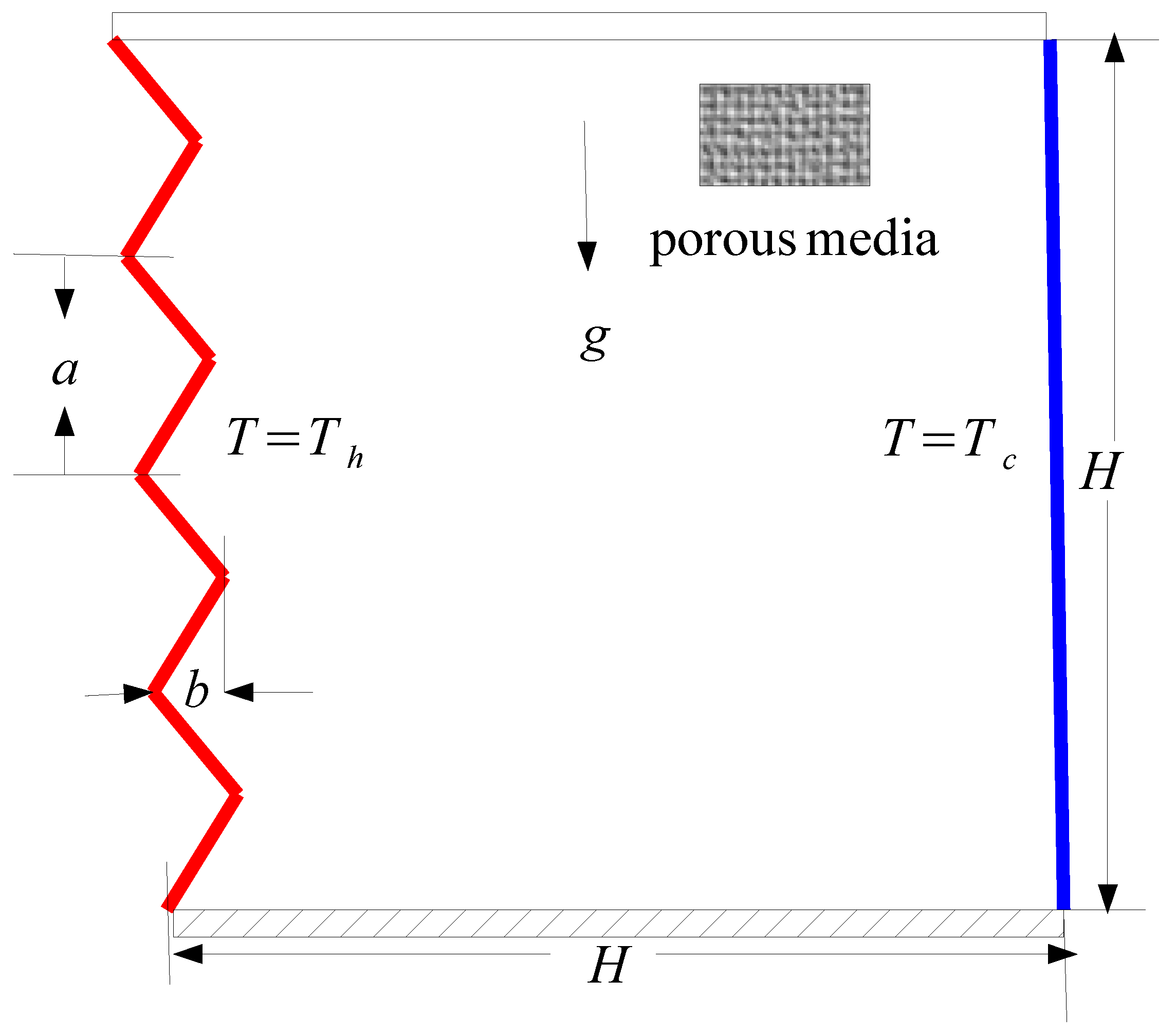
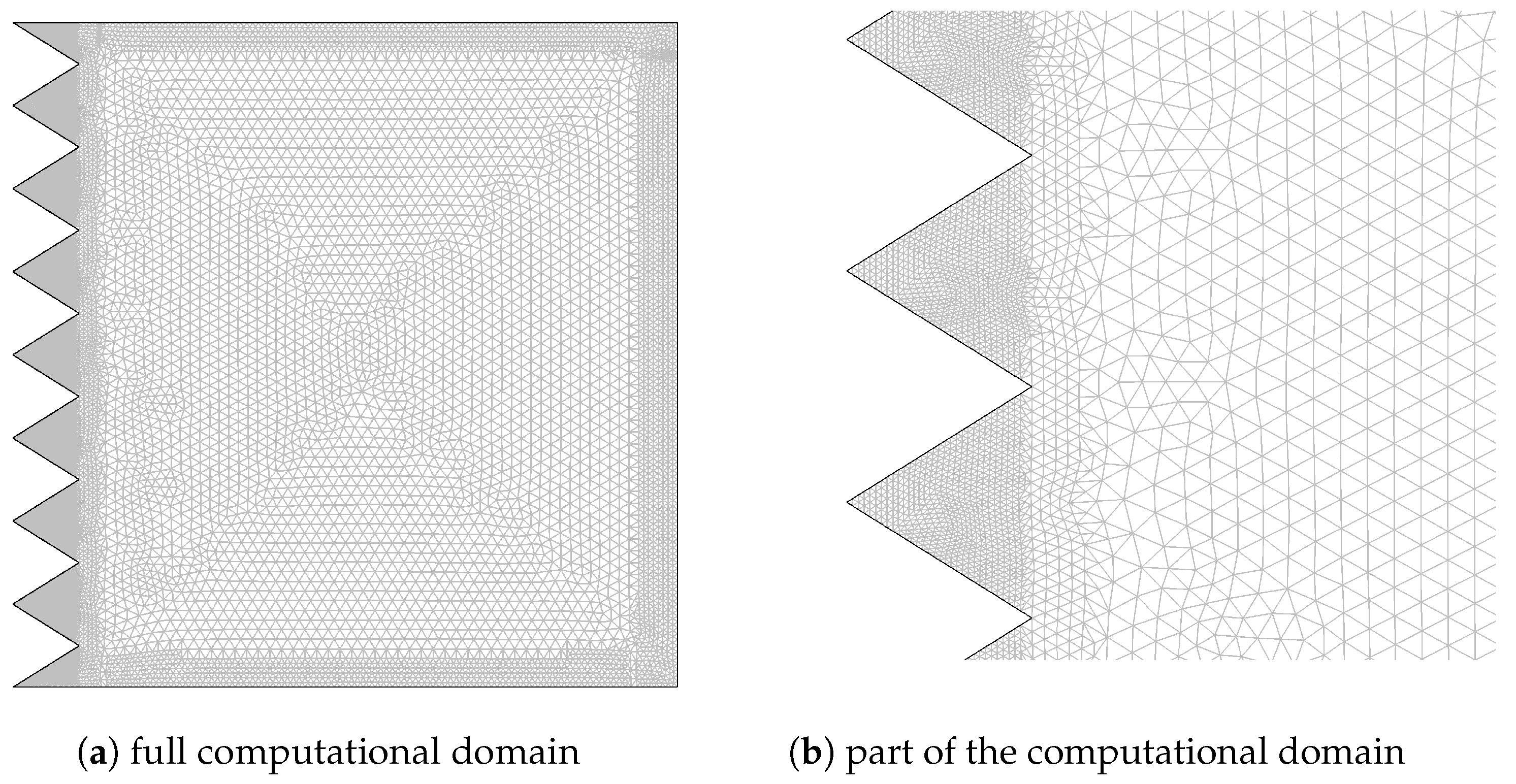
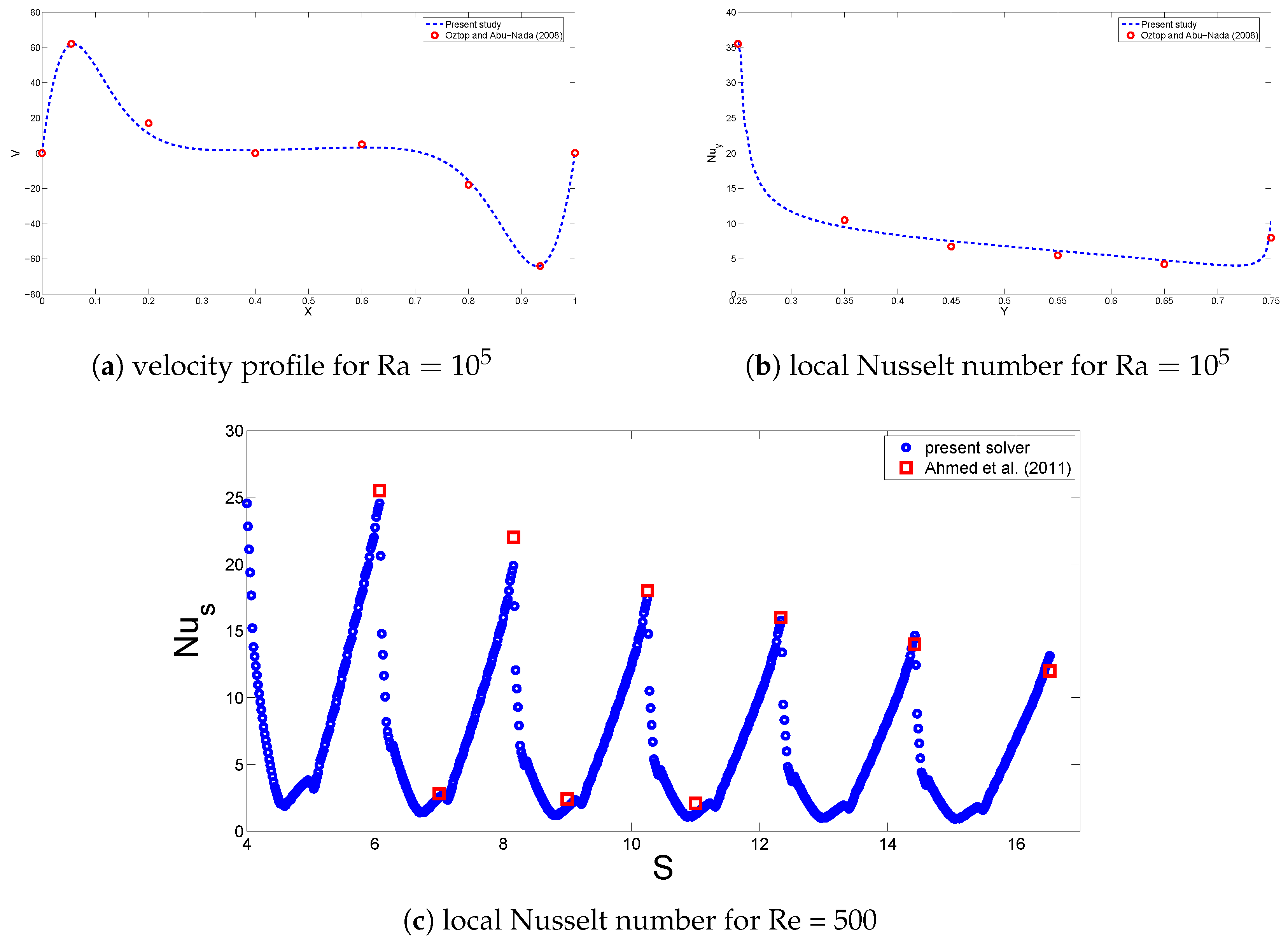



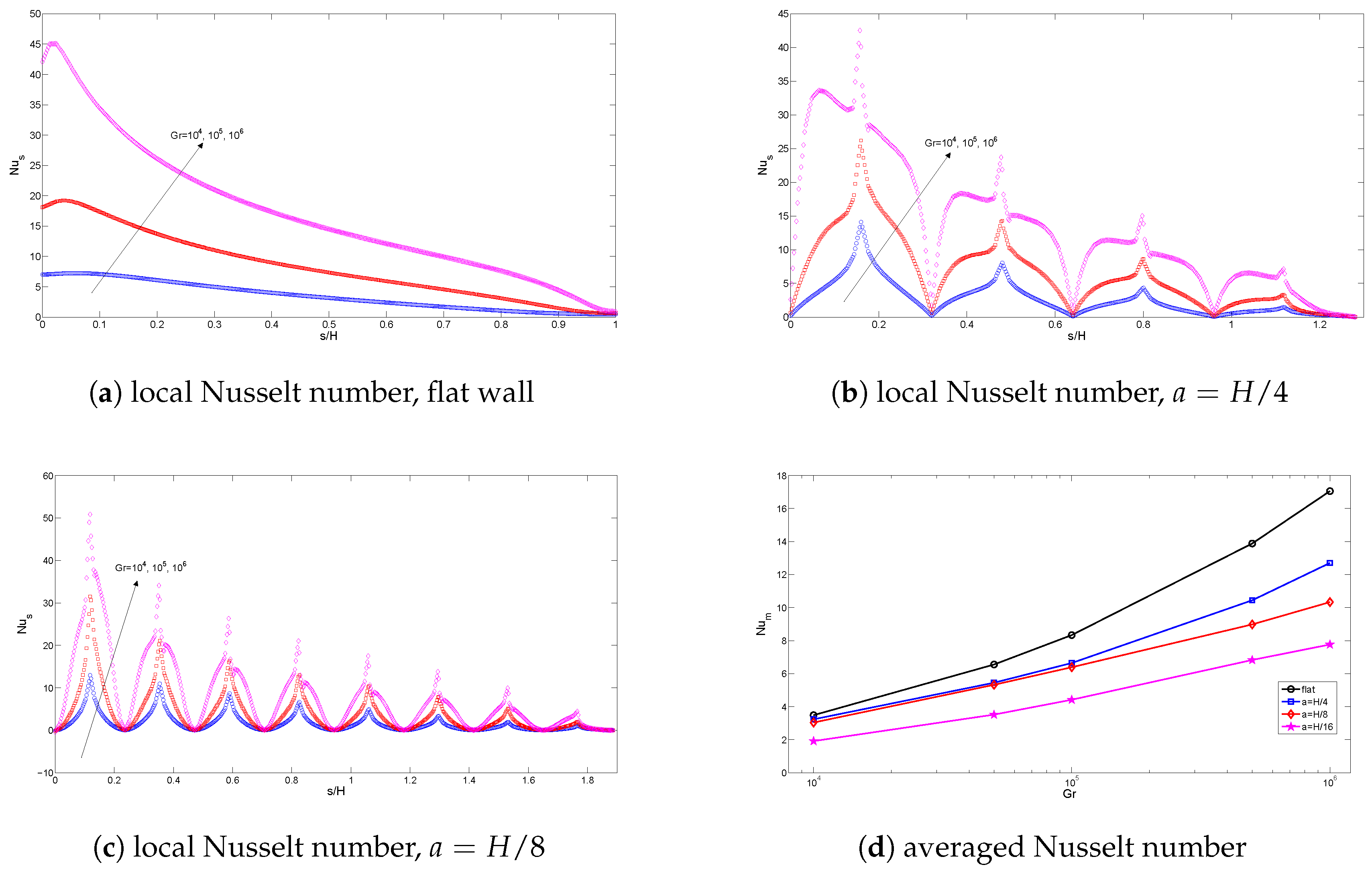
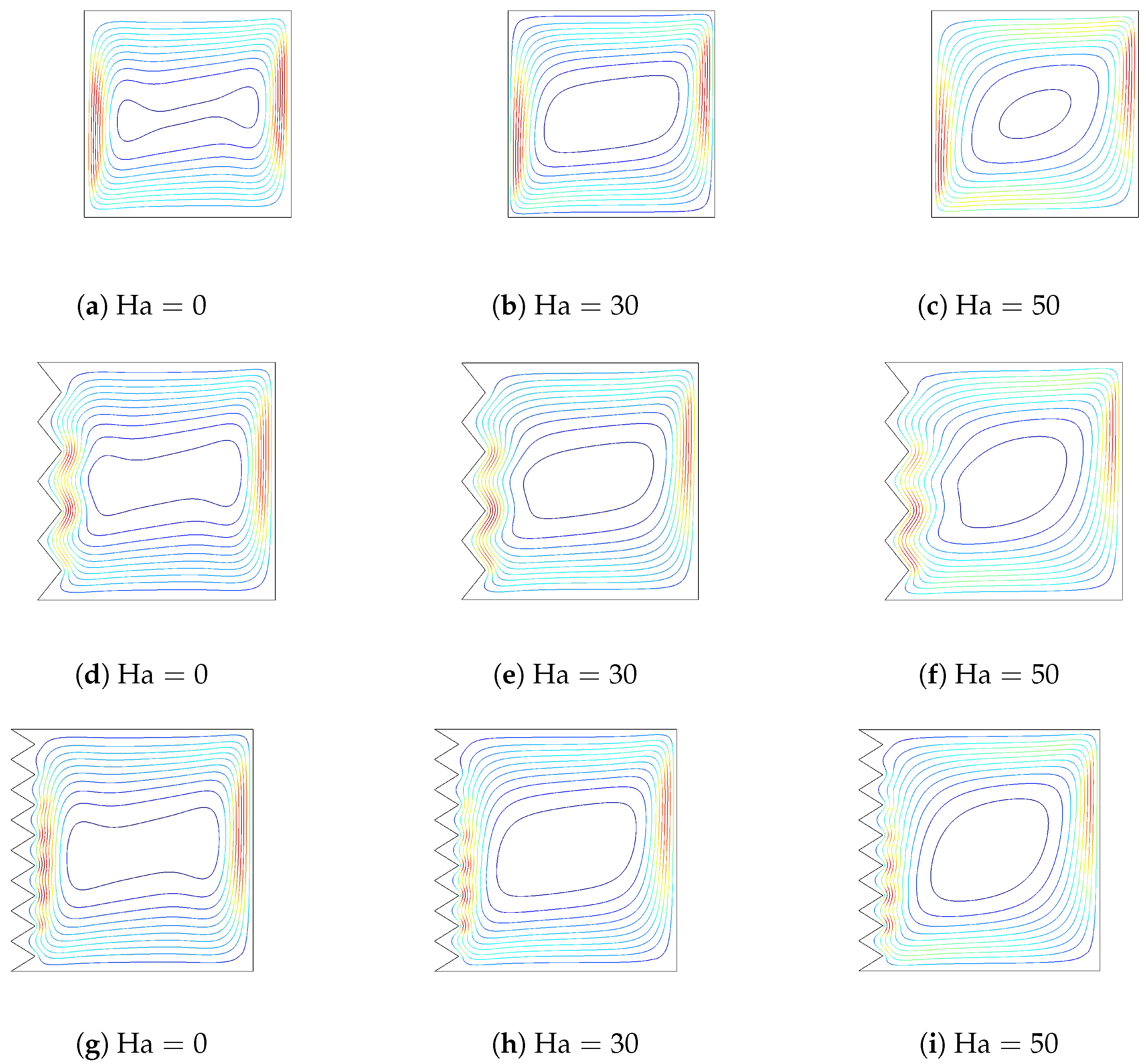

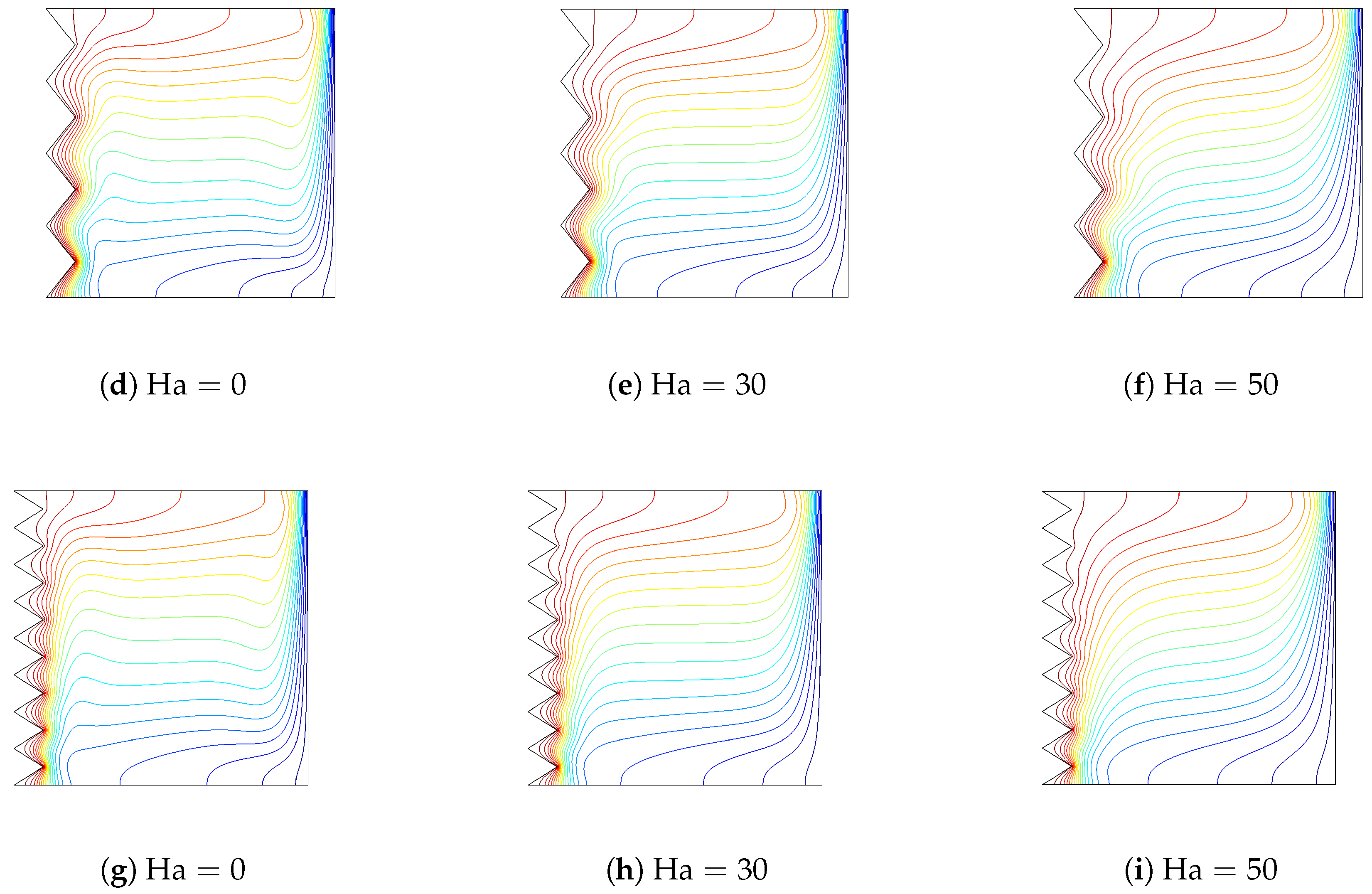



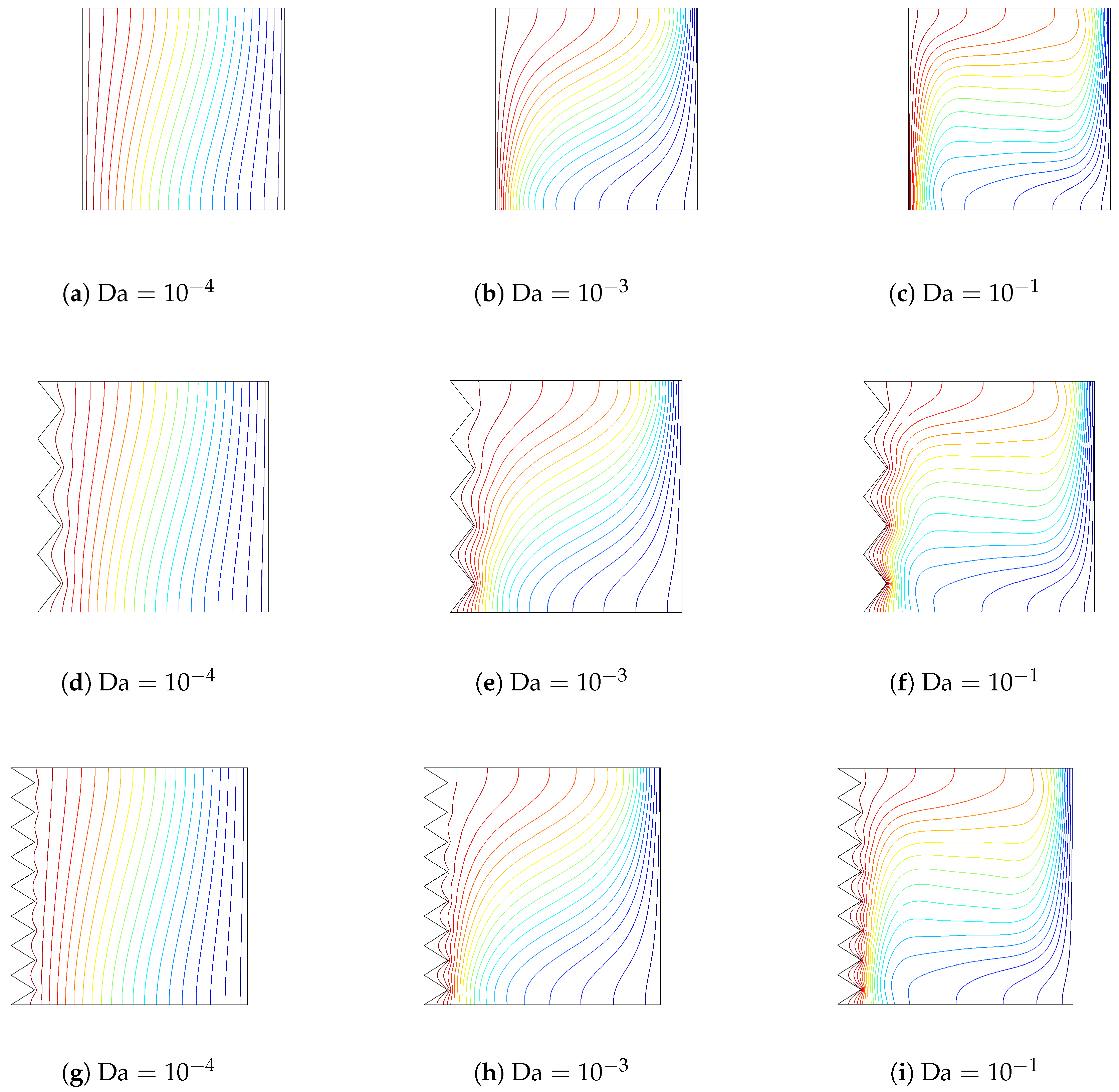
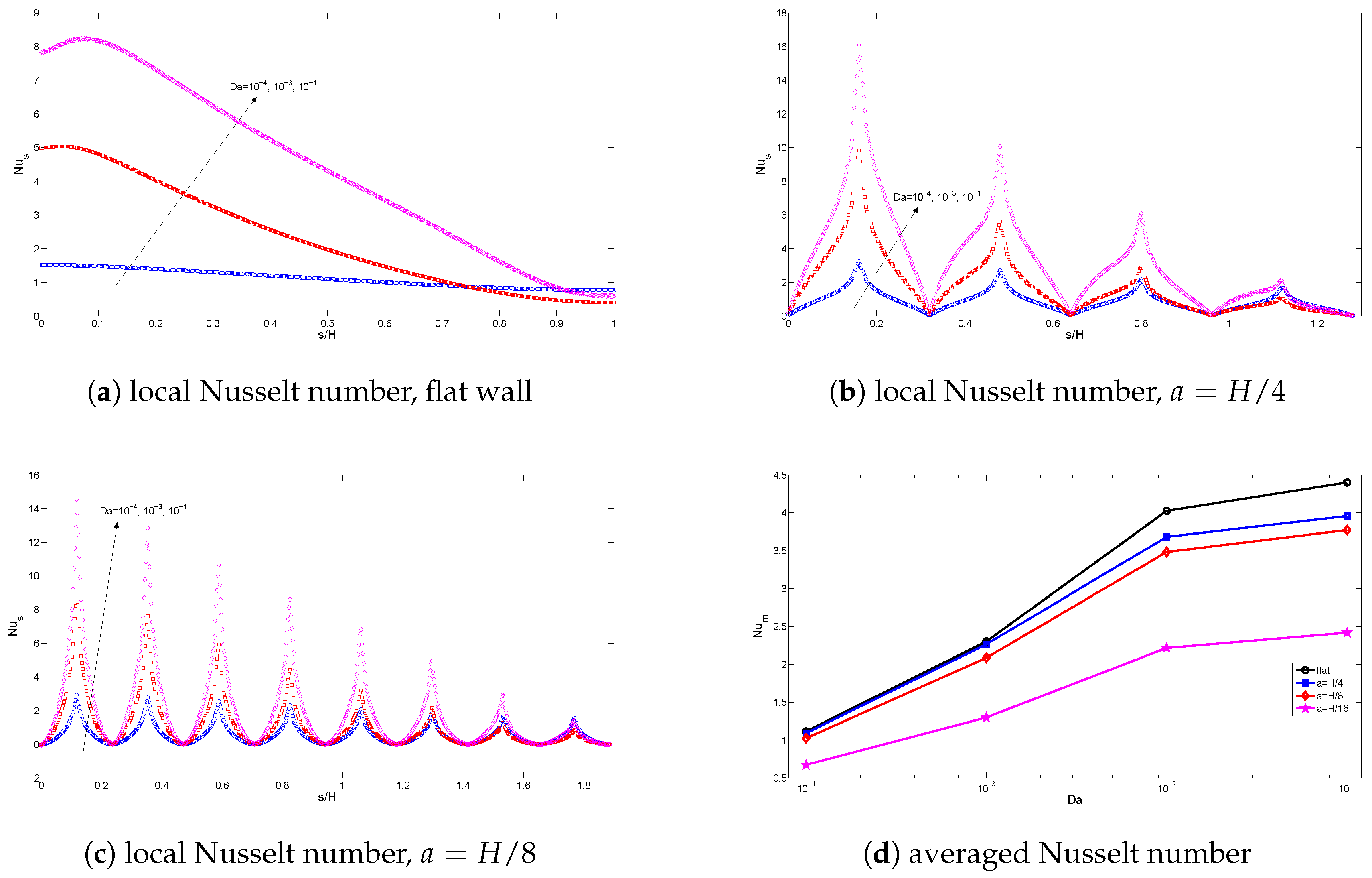

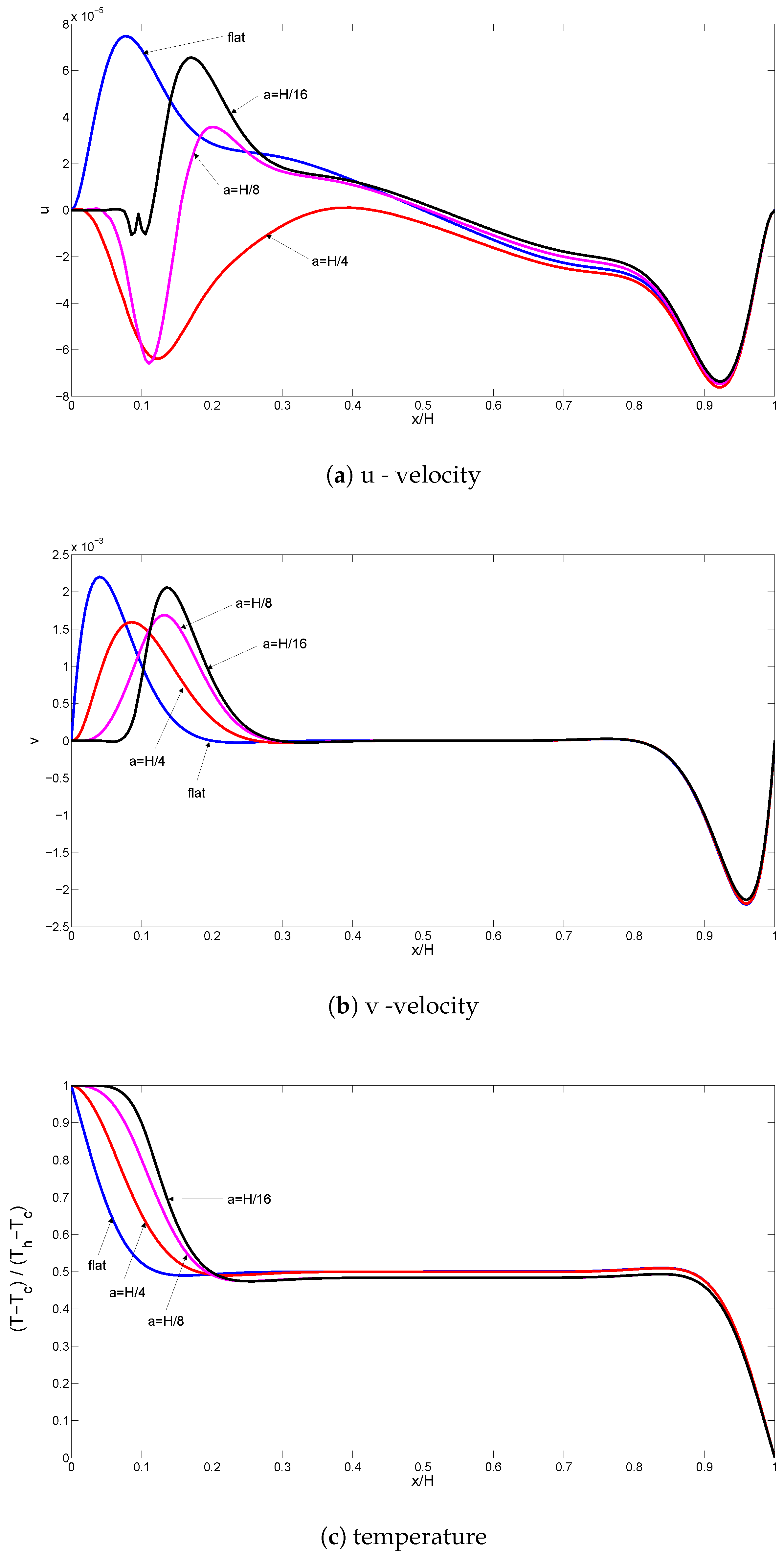
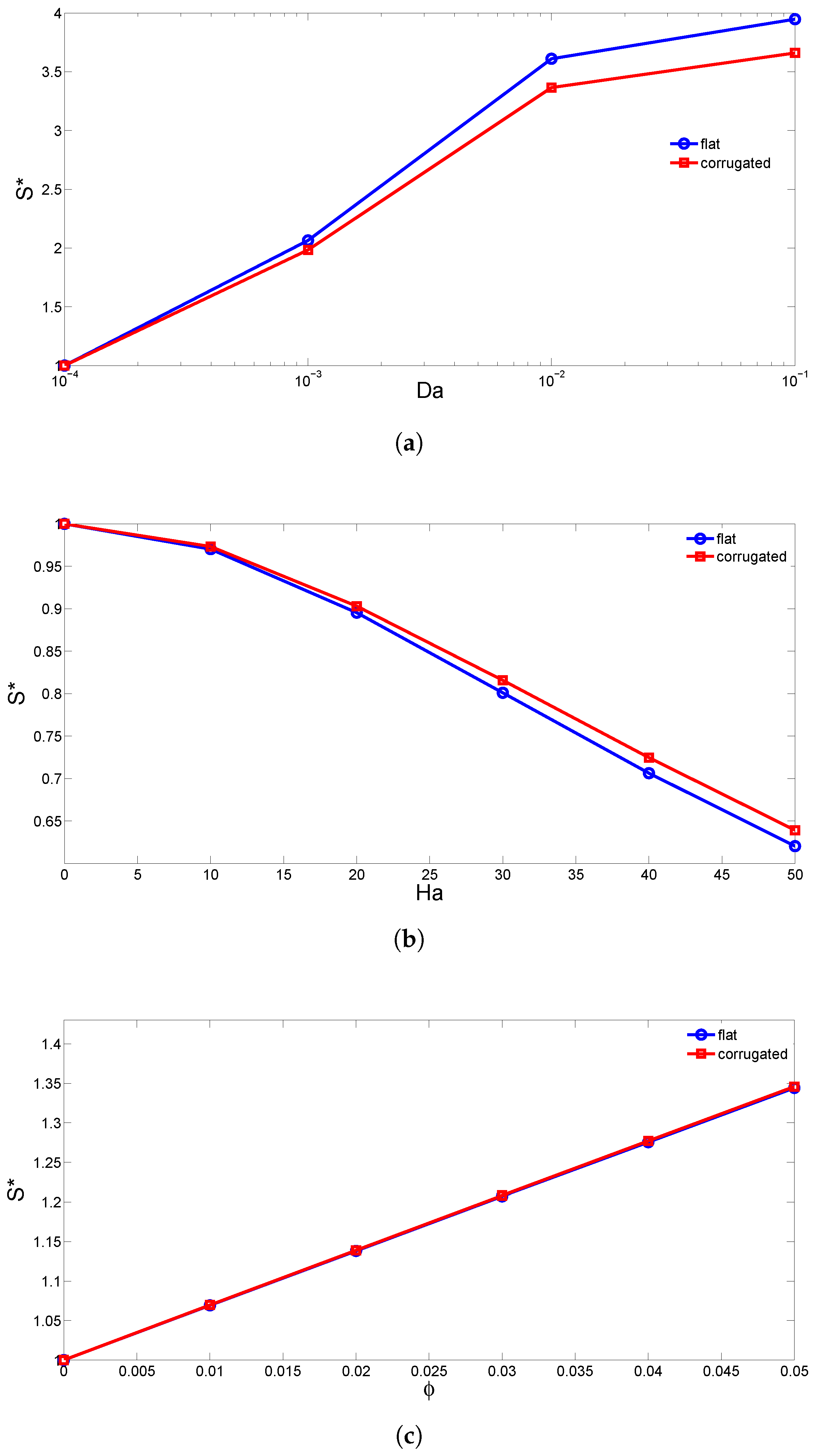
| Property | Water | Cu |
|---|---|---|
| 997.1 | 8954 | |
| 4179 | 383 | |
| k | 0.6 | 400 |
| 0.05 |
| Grid Name | Number of Elements | Averaged Nusselt Number |
|---|---|---|
| G1 | 1136 | 9.232 |
| G2 | 2796 | 9.983 |
| G3 | 4544 | 10.483 |
| G4 | 18,176 | 11.087 |
| G5 | 52,624 | 11.184 |
© 2018 by the authors. Licensee MDPI, Basel, Switzerland. This article is an open access article distributed under the terms and conditions of the Creative Commons Attribution (CC BY) license (http://creativecommons.org/licenses/by/4.0/).
Share and Cite
Chamkha, A.J.; Selimefendigil, F. MHD Free Convection and Entropy Generation in a Corrugated Cavity Filled with a Porous Medium Saturated with Nanofluids. Entropy 2018, 20, 846. https://doi.org/10.3390/e20110846
Chamkha AJ, Selimefendigil F. MHD Free Convection and Entropy Generation in a Corrugated Cavity Filled with a Porous Medium Saturated with Nanofluids. Entropy. 2018; 20(11):846. https://doi.org/10.3390/e20110846
Chicago/Turabian StyleChamkha, Ali J., and Fatih Selimefendigil. 2018. "MHD Free Convection and Entropy Generation in a Corrugated Cavity Filled with a Porous Medium Saturated with Nanofluids" Entropy 20, no. 11: 846. https://doi.org/10.3390/e20110846
APA StyleChamkha, A. J., & Selimefendigil, F. (2018). MHD Free Convection and Entropy Generation in a Corrugated Cavity Filled with a Porous Medium Saturated with Nanofluids. Entropy, 20(11), 846. https://doi.org/10.3390/e20110846






